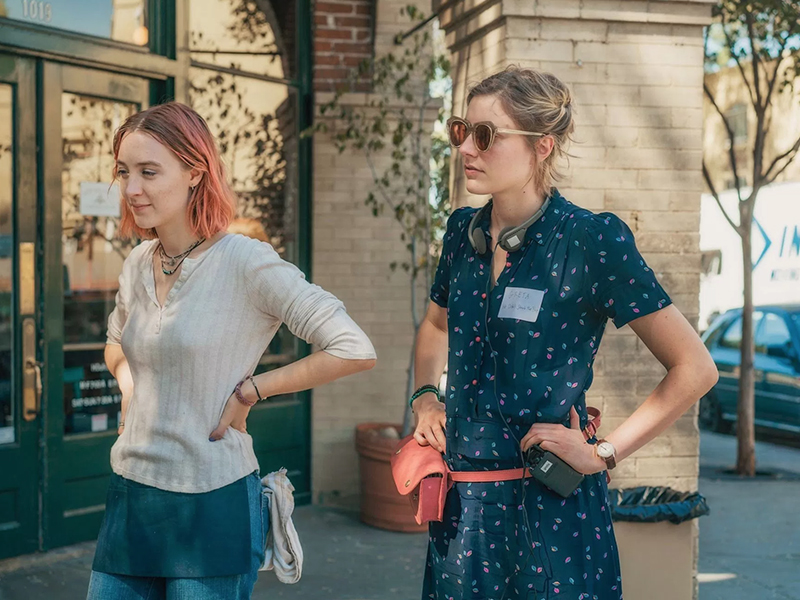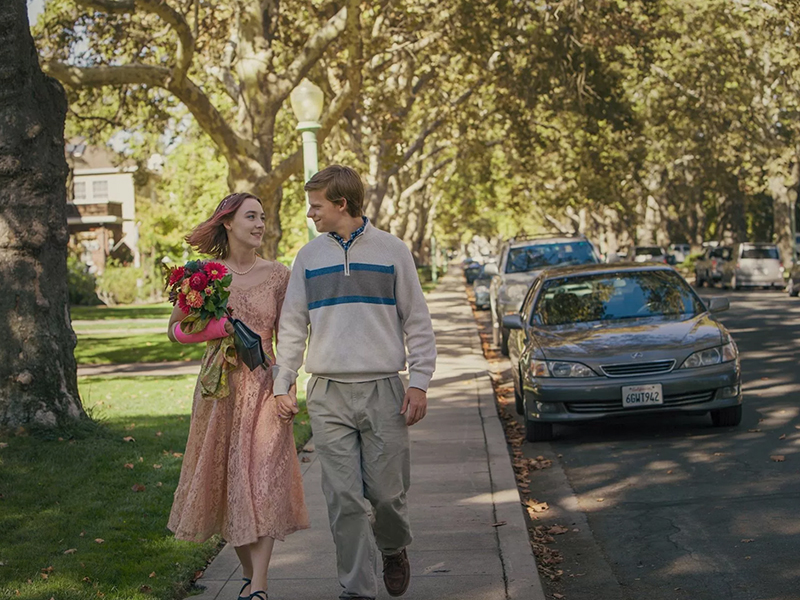(RNS) — “Lady Bird” — about a girl in her final year at Catholic high school navigating relationships with boyfriends, friends and her mother — was the winner of two Golden Globe awards last weekend.
The film by writer and director Greta Gerwig, who grew up Unitarian Universalist but attended Catholic high school, won for best musical or comedy motion picture and Saoirse Ronan (who plays Lady Bird) won for best actress.
Gerwig, also nominated for best screenplay, never went to film school and pulled much of the script from her own experience. She recently spoke to RNS about the religious setting and subtext of the film. This interview has been edited for length and clarity.
You’ve described this movie as a “love letter to Sacramento,” your hometown. But is it also a love letter to Catholic schools?
Definitely. I wasn’t raised Catholic, but I loved Catholic high school, and I loved my Catholic high school, St. Francis.

Lady Bird director Greta Gerwig, right, and director of photography Sam Levy during filming. Photo courtesy of Grace Hill Media
I was actually very different than Lady Bird. I wasn’t a rebel. I never made anybody call me by a different name or dyed my hair bright red. I never challenged authority. I was a very rule-following kid. But I encountered so many adults there who really impacted my life so positively. There were priests and nuns who were just compassionate and funny and empathetic and thoughtful, and they really engaged with the students as people, not figureheads. And that was also true of the lay people who were teachers — theology teachers or choir teachers and all these different parts of the school.
I felt, as a moviegoer, kind of making fun of Catholic school has been covered. There’s lots of movies that have this idea of making it into kind of a joke, and I wanted to do something that reflected more like the genuine guidance and interest and compassion I found in those people, and I didn’t want it to feel like they were just a nun with a ruler or something.
What does your depiction of the religious characters — the nuns, the priests — say about how people of different faiths and no faith can interact with and respect one another?
For me, as a person who was not raised Catholic, the warmth with which I was included in everything was deeply moving to me. To me, it’s something that even if you don’t share a background with someone, or even if you believe something different, there can be a quality of kindness and compassion that you can treat one another with — and respect. You can hold a space for them.
The brother school to ours was a Jesuit school, and one of the things that St. Ignatius said was you have to find God in all things. The idea was, you know, every person, every rock, every tree, everything — you have to find the divine in it, and I think I was treated that way. That doesn’t require that everybody think the same thing, but it does require that everybody approach each other with the same level of empathy.
While the setting of the film is religious, the story isn’t necessarily. Neither is the main character. It’s set in 2002, even before the “nones” were a hot topic. How does that comment on the presence of religion in our lives?
It’s funny because the character of Lady Bird is rejecting so much of it because she’s sort of rejecting everything. She’s in that moment of being 17 and saying, “What are you rebelling against?” “What have you got?”
For me, something that is important is that at the end of the movie when she’s gotten to the place where she thinks she wants to be, she finds her way back into a church and listens to a choir and lets that wash over her. I can’t speak to individually how people feel, but I do think that there is for me personally something deeply connecting about communal places and also communal rituals, and I think if you were raised with any kind of religion, there’s a way that ends up feeling like home in some deep way. I think that there’s a hunger for that, whether or not you can go in for the whole enchilada. I do think there’s a sense this is a place that we take time every week and we’re here all together. I don’t think that’s a thing people have lost. I think they’ve just put it in other areas.

Actor Saoirse Ronan, left and director Greta Gerwig on the set of “Lady Bird.” Photo courtesy of Grace Hill Media
My first love was theater, and that’s another gathering of people in a room that suspends disbelief and emotionally invests in other people onstage. That’s not very dissimilar in the sense of the gathering together and the being present in the moment. I think cinema is another version of that. I don’t really have an explanation, but I don’t think that need goes away.
There seems to be something almost divine about family in this movie. As she leaves the church, Lady Bird is calling her parents, and there’s something about the way she begs her mother to respond to her that’s reminiscent of prayer or crying out to a God that seems silent. Was that intentional?

Actor Saoirse Ronan, as Christine McPherson, demands others call her “Lady Bird” in the film by Greta Gerwig. Photo courtesy of Grace Hill Media
In other movies that I’ve written and in this one, I always have — and I do think honestly it reflects my four years of theology — I always have some religious story threaded underneath that people can pick up on or not pick up on. I don’t need them to, but it helps me as an organizing principle because even if you don’t believe in the stories, they are very old stories, and they do speak really deeply to people and their psychologies and how they deal with life.
For example, when she denies that she’s from Sacramento, that was, in my mind, sort of when the apostles deny Jesus and say, “I don’t know that man. I have no idea who he is.” And they say they won’t, and they do, because you would. And also you’re forgiven. I think that some of those themes that I like having in there, it’s not the text, but it is the subtext. I think those stories are very potent in talking about the human condition and human impulses that sometimes aren’t as noble as we would like them to be, and that doesn’t make you unworthy. That makes you human.

Faithful Viewer logo. Religion News Service graphic by T.J. Thomson





